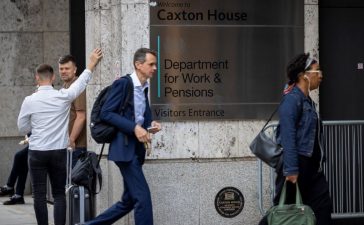Unlock the Editor’s Digest for free
Roula Khalaf, Editor of the FT, selects her favourite stories in this weekly newsletter.
Disaster insurance is critical in protecting homeowners and securing a nation’s economic and social stability. It mitigates the direct financial consequences of disasters, builds a safety net for recovery for those affected, and reduces the burden on public resources. However, the effects of climate change mean it is becoming increasingly unaffordable and in some areas unavailable.
Global warming has made disasters significantly more frequent and severe, driving up losses and the costs of recovery. In 2022 alone, floods in Australia and South Africa, hailstorms in France, winter storms in the US and Europe, and droughts in Europe, China and the Americas resulted in economic losses of $275bn.
While only half of these losses were insured, the cost of weather and climate-related disasters to the global insurance industry is increasing. In 2023, they reached $118bn: 31 per cent above the average for the 21st century. Some estimates suggest such losses could double in the space of a decade.
Consequences for insurers and homeowners
One result is significantly greater financial burdens for insurers. In response, they are charging higher premiums, which is making insurance unaffordable for many. In the UK, home insurance costs in 2024 are 36 per higher than they were in the previous year. In the US, some states have experienced a 40 to 60 per cent increase. And in Australia, 12.5 per cent of households in 2023 experienced extreme insurance affordability stress — up from 10 per cent in 2022.
Another consequence is that insurers are de-risking their portfolios by withdrawing cover in areas highly prone to natural disasters — leaving those most in need exposed. For instance, many underwriters have limited the sale of policies in US states including California and Florida, or have pulled out of some states completely. The lack of affordable property insurance forces many homeowners into financial distress.
Economic and social implications
Prohibitively expensive policies inevitably leave some properties completely uninsured. Many homeowners now find their monthly insurance payment is higher than their mortgage payment. Some of these are choosing to sell up, while others will find it difficult to do so.
A fragile insurance market also poses a significant threat to the wider economy. As banks become unwilling to risk granting mortgages, they reduce access to home ownership.
Test yourself
This is the seventh in a series of monthly business school-style teaching case studies devoted to responsible-business dilemmas faced by organisations. Read the piece and FT articles suggested at the end (and linked to within the piece) before considering the questions raised.
About the authors: Paula Jarzabkowski is professor of strategic management at the UQ Business School, University of Queensland. Konstantinos Chalkias is a senior lecturer at Birkbeck Business School.
The series forms part of a wide-ranging collection of FT ‘instant teaching case studies’ that explore business challenges.
The knock-on effects exacerbate inequality in societies. They deny many an asset that can be a source of wealth and future retirement funds. Moreover, residents relocating from high-risk areas can reduce income for local governments reliant on property tax revenues. That risks leaving the remaining community with budget shortfalls, squeezing funding for schools, police and other essential services.
Insurers’ withdrawal of coverage or loss of business due to the rising cost of premiums also undermines their own market. The continued growth of extreme weather events, especially in high-value areas, contributes to mounting losses and threatens insurers’ ability to maintain coverage and financial stability. Managing risk effectively while maintaining market share means balancing shrinking business opportunities or increasing exposure to climate-related losses.
Policy response and risk pools
Governments, regulators, insurers and homeowners are increasingly recognising the serious and widespread nature of disaster risk. Governments often intervene to set up national insurance or reinsurance risk pools to ensure the availability of insurance products and lower their costs. Examples of these risk pools, which are typically not-for-profit or reinsurance schemes, include Flood Re in the UK; EQC Toka Tũ Ake in New Zealand; and the NFIP in the US.
One approach is to reduce the premium paid, as is the case with the UK’s Flood Re, a reinsurance pool that receives a £10 levy from every home insurance policy.
This mechanism, known as risk redistribution, diversifies the risk across the entire insured population to allow affected households to remain in the pool of the insured. Flood Re has been shown to be effective since its inception in April 2016 by lowering insurance premiums in high-risk flood areas by more than half.
Dilemmas and their implications
For individuals in high-risk areas, subsidised insurance enables them to stay in their homes and maintain community ties, knowing they have disaster cover to support recovery. However, this reliance on subsidised insurance can diminish awareness of increasing climate change risk — reducing the urgency for relocation or adaptation measures.
A high insurance premium is a signal of the impact of climate change. When it is suppressed, though, it desensitises societies to the urgency of adaptation. Consequently, individuals might face repeated disasters as climate impacts intensify, perpetuating a cycle of vulnerability.
For governments, subsidising insurance using risk pools ensures that cover remains accessible, supporting social stability and mitigating economic disruptions. These interventions can enhance the overall capital available for disaster recovery.
However, this approach can also create a moral hazard, where individuals and businesses at risk rely on government insurance for recovery. This strategy can strain public finances and may not adequately address the long-term needs for climate adaptation, leaving future generations to bear the costs of inaction today.
Insurers, meanwhile, face a delicate balance in managing financial viability while providing coverage in high-risk areas. Increasing premiums or withdrawing from these markets may protect their financial health but can lead to a shrinking customer base and public backlash.
High premiums can render insurance inaccessible, undermining the industry’s role in safeguarding against disaster-related financial losses. Insurers thus need to innovate and adapt, developing new risk assessment tools and insurance products and even potentially a new operating model tailored to the evolving climate landscape.
Conclusion
The interplay between property insurance, climate change and economic stability presents a complex challenge requiring co-ordinated efforts from all stakeholders. The effectiveness of policy responses and the willingness of societies to adapt will significantly shape the future landscape of disaster risk management and insurance. Balancing immediate needs with long-term resilience is crucial for sustainable development in a changing climate.
Questions for discussion
Read:
https://www.ft.com/content/ed3a1bb9-e329-4e18-89de-9db90eaadc0b
https://www.ft.com/content/0975428c-9f9c-4e5b-837b-aeecc7e78db9
Consider these questions:
-
If insurance for disasters such as floods, storm-force winds and fires is no longer available or affordable for some homeowners, how will they be affected? How might these effects spill over to local communities and local governments in high weather risk areas?
-
What are the implications for the insurance sector if insurance premiums in high weather risk areas increase until they are disproportionate to homeowners’ income or the value of their properties?
-
Should insurers, as profitmaking businesses, be regulated to provide affordable insurance in high-risk zones no matter what?
-
What should the role of government be in the insurance market? Should it intervene by playing the role of an insurer, or should it remain separate and focus on regulation?
-
How sustainable is either private or public sector insurance if risk continues to grow under climate change? What else needs to happen in the wider environment for insurance to remain a viable long-term product in the face of climate change?










